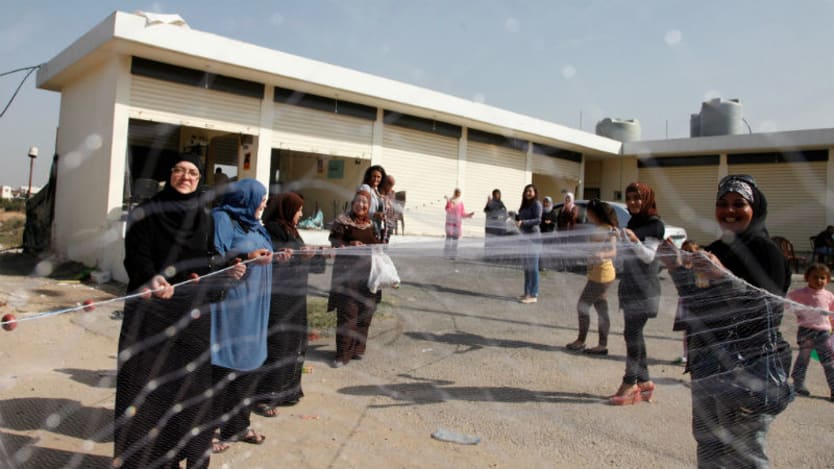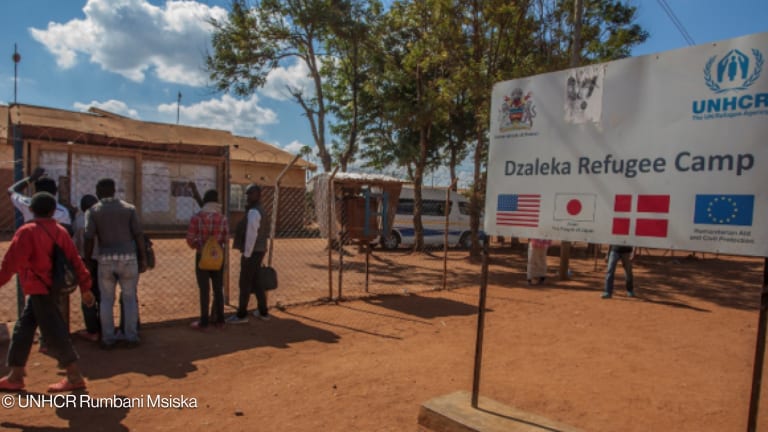
According to the United Nations, the current refugee situation is now considered to be the largest refugee crisis in recorded history. With more than 3 million Syrian refugees hosted in neighboring countries Lebanon, Turkey, Jordan and Iraq, and more than 1 million spread out across Europe, the question of how to best integrate large numbers of new refugees into host societies has become a critical one.
From providing adequate housing, to the education of children and livelihood opportunities for adults amidst the internal pressure of increasingly hostile host populations, governments, international and nongovernmental organizations alike are grappling with decisions about how to tackle the long-term issues of sustainable integration.
Devex spoke to a number of organizations responsible for facilitating the intake of refugees into their new host countries, to learn about their biggest challenges and best practices when it comes to ensuring a smooth integration of refugees at their destination.
Tackling education strategies
For the countries neighboring Syria, providing refugee children with education, and adults with livelihood opportunities are two of the biggest ongoing challenges.
Prior to the conflict, the literacy rate in Syria was 90 percent, with more adolescents enrolled in school. Five years later 2.7 million Syrian children are out of school, many of them entering the workforce to help support their families.
Kari Diener, deputy policy adviser at Mercy Corps, is particularly concerned about the interrupted education and low enrollment rates of adolescents.
“These are the people who will be responsible for rebuilding the country once the conflict ends,” she said. “They are Syria’s future — and right now, they aren’t even close to getting the preparation they will need.”
The factors leading to such low enrollment rates are numerous: Language barriers, overenrollment in schools, and missing paperwork that families desperate to flee dangerous situations might not have thought to take with them, to name but a few. Most children and adolescents have also had significant breaks in their education — sometimes lasting several years — due to conflict, making it difficult for them to resume their studies.
In some cases — particularly in countries where parents do not have the right to work — humanitarian workers are seeing more and more children sacrificing their education to enter the workforce as child laborers, which puts them at a lifelong disadvantage. Those children lucky enough to secure a spot in school struggle to adapt to the new subject matter and educational system.
Jordan and Lebanon have been able to increase the enrollment of refugee children by having them attend schools in double shifts, and Mercy Corps is currently helping Jordan expand its capacity in education by helping to build classrooms, so such shifts won’t be so necessary. The organization has found that integrating Syrian children into the same classes with the Jordanians, rather than having them attend classes separately, has had improved social cohesion, by reducing conflict between Jordanian and Syrian children. Anecdotally, teachers in the newly integrated classrooms, also reported improved test scores.
“When people have a job, they begin to rebuild the self-esteem and sense of autonomy they sometimes lose when they become refugees.”
— Pindie Stephen, senior migrant training specialist and integration focal point at IOMOvercoming obstacles to improve livelihoods
In an effort to provide education to those who may not have access to formal schooling, more and more humanitarian organizations are also exploring informal educational options — such as online certificate courses, or tests that children can prepare for online or at home.
“As we see more kids out of school one or two years, it’s increasingly difficult for them to return, so education that allows them to do it in the evenings, or online possibilities is really critical,” said Diener.
In order for informal educational opportunities to be truly effective, she cautioned, they would need to lead to degrees or certifications recognized by the countries hosting refugees, as well as Syria — something that organizations are just beginning to look into.
“The key here is that the education received in one country needs to transfer to Syria when they return,” Diener said.
Which leads to one of the biggest long-term challenges: Helping refugees find jobs.
For organizations working with refugees in their new host countries, that means finding the delicate balance between providing refugees with the support they need to thrive, while also giving them the autonomy to do things themselves. The first step might be enrolling them in language training, so they can immediately start building a social network. But the most important milestone is securing employment — which is critical to establishing a work history, and learning the soft-skills of their new cultural environment.
“Getting the first job is the most critical step,” said Pindie Stephen, senior migrant training specialist and integration focal point at International Organization for Migration*. “It’s really important to addressing the issue of learned helplessness, and breaking that cycle of dependency that refugees that have lived in protracted refugee camps often develop.”
In most countries only recognized refugees have the right to work — though some countries, like Germany, have changed their laws and extended employment opportunities to asylum-seekers, according to Stephen. Currently, however, many of the countries hosting the largest numbers of refugees — including Turkey, Lebanon and Jordan — do not grant them the right to work. For development and humanitarian organizations working with refugees, “livelihood strategies” therefore often cross over into advocacy with local governments.
“There’s a political issue of how to change some host government policies that currently hinder the success of livelihood initiatives,” said Susan Fratzke, a policy analyst and program coordinator at Migration Policy Institute. “There are a lot of different possibilities that development organizations are trying and interested in trying, in order to connect refugees with livelihood opportunities — but if there’s no right to work, or own property, or even access to education, there’s not much they can do. So the task now is to figure out how to exert pressure on government to adapt their policies.”
There is some positive movement in this regard: According to Diener, Jordan has been looking into the possibility of expanding special economic zones where refugees could work, with the aim of eventually building stronger cross-border economic ties post-conflict. And according to Fratzke, Jordan and Lebanon have been experimenting with giving refugees and residents access to computer training and vocational skill programs.
Diener emphasized the importance of implementing multisectoral, evidence-based solutions.
“We need programs that go beyond handouts,” she said. “For us, that means being thoughtful, and actually listening and responding to refugees needs, designing programs that address those needs, and taking the extra time to do research that ensures the program is responsive and has an impact.”
There’s also the issue of psychological and mental health care, which if left untreated can have serious long-term consequences.
“This is something that we are becoming more aware of as the crisis goes on,” said Diener. “Some of the most recent trauma research indicates that the factor that is the best predictor of whether an individual will experience [post traumatic stress disorder] or continued stress throughout their life is how they are responded to initially coming out of that trauma.”
Unfortunately, with the more immediate concerns of providing adequate food and lodging, and then education and livelihoods, psychological care and follow up is often neglected.
Making the most of pre-departure orientations
For the refugees that are deliberately placed by UNHCR in host countries — as opposed to asylum-seekers that cross borders undocumented, fleeing violence, and have not yet achieved official refugee status — “integration” should begin abroad, before refugees physically arrive in their new host countries, and start with a pre-departure orientation.
For refugees going to Canada, the pre-arrival orientation process takes approximately 15 hours, and aims to familiarize them with what to expect — from understanding the geography, system of government, education and health care system, to learning more about their entitlements and responsibilities, and finally what settlement agencies and services will be available to them.
According to Stephen, this orientation is critical to prepare refugees to transition to life in a new country and culture.
“We try to counsel them on what to expect when they arrive in the host country — from enrolling their children in school, to taking language courses, to social norms and expectations,” she said, adding the importance of addressing issues related to culture shock, managing adaptation strategies, and giving refugees advice on ways to mitigate stress.
“We remind them that it is perfectly normal, over a period of anywhere from six months to five years, to experience the various phases of culture shock ... before eventually adapting and becoming adjusted,” Stephen said. “These reactions will vary according to each individual and their respective refugee experiences and persecution history.”
An equally important part of pre-departure orientation is managing expectations. According to Stephen, most refugees get their initial information about what life will be like in the new country from family and friends, which often includes a lot of misinformation.
“It’s important that refugees have realistic expectations for the initial period of resettlement,” said Stephen. “They have to start thinking long-term and proactively planning to get on the pathway to self-sufficiency.”
Making sure case managers share the culture both of the refugees and the country that will be hosting them, whenever possible, and giving refugees access to long-term language programs before they are expected to work, are two practices helpful to smoothing refugees’ transition into society.
“Bi-cultural facilitators and volunteers are critical bridges between Syrian refugees and the new host country, and serve as role models that have successfully integrated into the host society,” Stephen explained. “Refugees will ask them questions they might not ask otherwise, because they feel more comfortable opening up to someone who understands their language and culture.”
Using volunteers effectively
Capacity is a major concern for nearly all organizations, many of which are struggling to work effectively amidst the pressure created by significantly larger numbers of refugees than they are accustomed to serving.
Over the past three months, in the middle of winter, Canada received 25,000 new Syrian refugees. Mario Calla is the executive director of COSTI Immigration Services, the organization responsible for managing refugee reception in Toronto. With months to prepare, Calla thought he was ready. He was wrong.
“We usually receive 900 refugees over the course of the year,” he explained. “So getting 2,000 refugees over the course of three months was overwhelming.”
Their organization wasn’t the only one struggling: After the first three weeks, Toronto, Vancouver and Ottawa requested the government halt new arrivals for five days, in order to give their organizations time to analyze, and adjust to the heavy intake.
Calla quickly realized that they would need more support to do their job well.
“We had hired more people before their arrival, but even with the additional staff, there were many needs that we didn’t anticipate,” he said.
Security, for example: Because many of the refugee families came from rural areas, where children were watched by all adults in the village, parents were relaxed about supervision. It quickly became apparent that COSTI would have to hire security personnel to watch hotel pools so children wouldn’t enter them unsupervised, and to make sure that children didn’t run out of the hotels into the snow. They also struggled with finding sufficient numbers of translators, and coming up with activities to entertain bored children inside the hotels, until families were placed in more permanent housing units. And while an enormous number of volunteers turned out from the community to help support COSTI’s work, it took his organization some time to learn how to effectively manage them.
“We basically created groups of volunteers to manage the other volunteers,” he explained, which freed up COSTI staff to do their job. One group managed the donations and distribution of clothing, while another was designated to create activities for children. A third group — most from Arabic-speaking Canadian communities — worked as translators, while another worked closely with realtors to try to locate affordable, long-term housing.
COSTI also created a system to vet volunteers and created agreements that volunteers signed before working with refugees, outlining certain protocols that needed to be followed; for example, keeping refugee information confidential, not bringing press to speak to refugees, and refraining from engaging in activities that might be considered conflict-of-interest.
“It took us some time to come up with this system, but afterwards everything went much smoother,” Calla said.
Facing the funding challenge
All humanitarian organizations working with the protracted Syrian conflict face funding challenges.
According to Fratzke, there is a fundamental flaw with the way that humanitarian funding is structured in that it is almost universally short-term (usually around six months), making it difficult for organizations to address longer-term issues such as how to create sustainable livelihood opportunities or even long-term psychological care, which traditionally is addressed by the development community.
Similarly, because humanitarian work around livelihoods in the context of the Syrian crisis is relatively new and unique to the countries where Syrian refugees are being hosted, it is difficult to know what programs will be the most effective.
As the Syrian conflict continues, leading to even more refugees leaving the country in search of safety, finding solutions to these long-term issues will be critical.
“The longer this crisis goes on, the more areas of need we see coming out,” said Diener. “Really, we need to see an end to this conflict — and sooner rather than later. Unfortunately, that’s an unlikely reality.”
What does the future hold for those people coming #AcrossBorders? How will this issue shape global dynamics in the coming decades and what represents success for global development and humanitarian actors in the transition from destination to integration? Have your say by leaving a comment below.
Across Borders is a monthlong online conversation hosted by Devex and partners — World Vision, the European Commission's Humanitarian Aid and Civil Protection department, the U.S. nonprofit partner of the International Organization for Migration and United Nations Volunteers — to analyze and amplify the discussion on global migration and current refugee crises through the lens of global security, development cooperation and humanitarian aid work, and more. Visit the campaign site and join the conversation on social media tagging @devex and #AcrossBorders.
*Correction, March 23, 2016: This article was updated to reflect that Pindie Stephen is a senior migrant training specialist and integration focal point at International Organization for Migration








